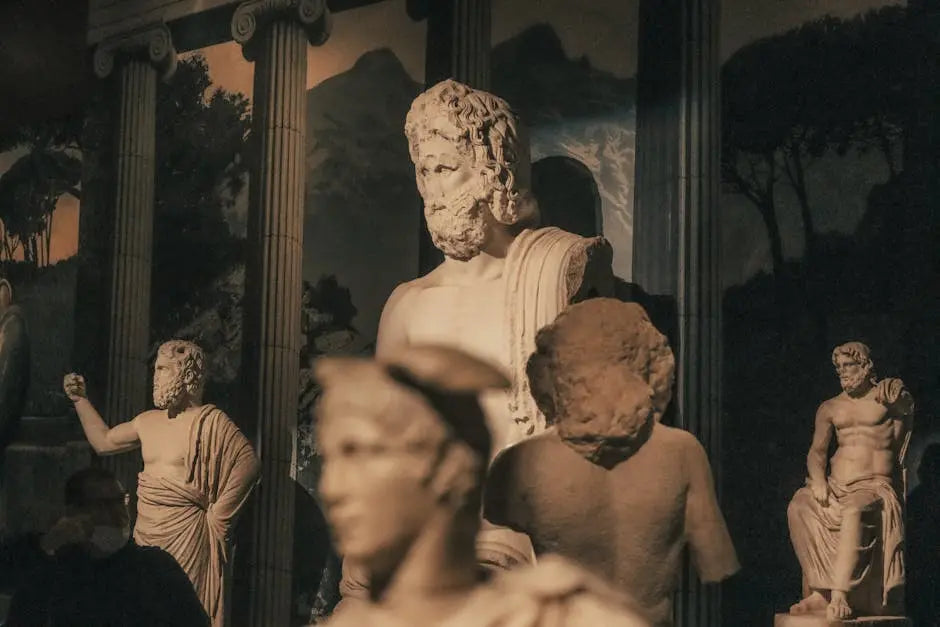My Cart
Your Cart is Currently Empty
FREE SHIPPING ON ALL ORDERS ABOVE $500


Stone sculptures have long captivated art lovers with their grandeur and timeless elegance. In the realm of modern art, several stone creations have stood out, defining movements and setting precedents. This blog explores some of these masterpieces that have carved out a place in art history.
Henry Moore revolutionized modern sculpture with his abstract stone forms. He had a unique ability to mold stone into fluid and organic shapes, evoking mystery and curiosity through each curvature and hollow. His works, such as ‘Reclining Figure’ and ‘Family Group,’ showcase a sophisticated understanding of human anatomy, further extending his fame and influence in the art world. Moore’s approach often blurred the lines between sculpture and its surrounding space, encouraging viewers to interact with his stone forms from multiple perspectives.
Barbara Hepworth’s work in stone is renowned for its serene forms and natural harmony. Her pieces often explore the relationship between humanity and nature, emphasizing form and space, drawing attention to the positive and negative forms present within each sculpture. Hepworth’s commitment to craftsmanship is evident in works like ‘Single Form,’ a tribute to Dag Hammarskjöld, which illustrates her ability to blend form with meaning.
In addition, Hepworth’s exploration of pierced forms allowed light to interact with her sculptures in innovative ways, creating an almost ethereal presence. This technique not only added a dynamic element to her work but also reinforced the interconnectedness of her sculptures with the natural environment.
Auguste Rodin’s contributions to stone sculpture cannot be overstated. His realistic and emotive works broke away from classical traditions, prioritizing expression over formality. ‘The Thinker’ remains one of his most iconic pieces, capturing the contemplative nature of humankind with stunning clarity. Rodin’s work is characterized by his ability to convey complex emotions, as seen in pieces like ‘The Kiss,’ where passion and tenderness are carved into every curve.
Rodin’s legacy continues to endure through his innovative techniques and ability to bring stone to life. His use of texture and attention to detail imbue his sculptures with a sense of realism and movement, enticing viewers to feel the palpable tension and emotion within each piece.
Constantin Brancusi is known for his minimalist approach to stone sculpting, where simplicity and essence were key. His works are characterized by smooth, sleek lines and a profound sense of spirituality. ‘Bird in Space,’ one of his most distinguished sculptures, showcases Brancusi’s mastery over abstraction, capturing the essence of flight through a graceful, elongated form.
Brancusi’s pieces often inspire contemplation, drawing viewers into a deeper understanding of his art by transcending the physicality of the medium. His influence on modern sculpture is indelible, paving the way for artists who seek to express purity and emotion through streamlined forms.
Isamu Noguchi synthesized Eastern and Western influences in his stone sculptures. His work is celebrated for its emotional depth and exploration of light and shadow. Noguchi’s ‘Stone Carving’ exemplifies his unique ability to convey intricate details through precise carving techniques, managing to bring out the stone’s inherent beauty while also creating an emotional narrative.
Noguchi’s affinity for blending tradition with innovation gave birth to works that were both modern and timeless. His engagement with light and shadow created dynamic interactions within his sculptures, inviting the viewer to explore each piece from every angle, unraveling layers of meaning in the process.
Anish Kapoor is a modern master of monumental stone sculpture. His works often engage with large-scale dimensions and challenges viewers’ perceptions of space. Pieces like ‘Marsyas’ and ‘Cloud Gate’ illustrate his commitment to altering ordinary perspectives, enabling audiences to become enveloped in an entirely new spatial experience.
Kapoor’s use of reflective surfaces and bold colors in his stone works creates a dialogue between the sculpture and its environment, blurring the boundaries of perception and reality. His innovative approach continues to captivate the imagination, drawing attention to the potential of stone as a medium for transformative experiences.
Richard Long’s approach to stone is highly textural and kinetic. His land art and stone arrangements challenge conventional ideas of sculpture and engage directly with the surrounding environment. Long’s emphasis on texture and materiality allow him to create works that are deeply connected to the landscapes from which they originate.
Through pieces like ‘A Line Made by Walking,’ Long explores the passage of time and human interaction with nature, leaving a mark on both the land and the viewers. His minimalist yet impactful designs highlight the simplicity and raw beauty of stone, fostering a greater appreciation for the natural world.
Louise Bourgeois is known for infusing psychological themes into her stone sculptures. Her organic and biomorphic forms often reflect themes of family and femininity. Works like ‘Maman’ explore maternal strength and vulnerability, while pieces such as ‘Crouching Spider’ evoke themes of protection and entrapment.
Bourgeois’ use of stone as a medium allows her to investigate these complex themes through a tactile, physical presence. Her sculptures invite viewers to engage with their intricately carved surfaces, sparking introspection and emotional resonance through the intertwining threads of personal narrative and universal experiences.
Judy Chicago challenged the boundaries of stone sculpture with her innovative installations. Known for her pioneering work, ‘The Dinner Party,’ Chicago’s impact on the art world extends to her stone pieces, which often address feminist themes and question societal norms.
Chicago’s collaborative approach to stone art invites diverse perspectives, highlighting the power of collective creativity. Her installations serve as a call to action, encouraging viewers to question traditional roles and consider the significance of gender and identity in contemporary society.